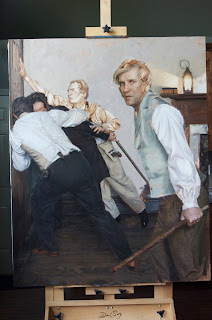Process to Create "Greater Love Hath No Man"
Prints are available HERE
**UPDATE** I'm currently working on the second panel of this painting originally designed as a diptych. The second panel, which will be displayed on the left, will show the members of the mob outside the door. The wood frame in the middle of the two panels will act as the wall separating the inside and outside of the room. Here's an article from the Daily Herald about the photoshoot. The completed piece will be on display at the Church History Museum fall of 2015. Prints will be available once the painting is completed
********
I'm happy to announce that my new painting, Greater Love Hath No Man, received the Charles & Ruth Whiting Award during the 26th Annual Spiritual and Religious Art of Utah Exhibition at the Springville Museum in Springville, UT! Here are a couple news articles for the show:
Spiritual snapshots: Popular religious exhibit makes annual appearance at Springville Museum of Art
26th annual Spiritual and Religious Art Exhibit offers inspiration & variety
I've been wanting to show the process I took to create my recent painting, Greater Love Hath No Man, and my research to make it historically accurate, so here goes... The entire painting is not yet finished--the finished painting will be a diptych, so this is detailing the process and research behind the first completed panel.
The Idea
The painting has been a personal project of mine beginning in 2009 when I had the impression to capture the moment right before Hyrum Smith was shot in Carthage Jail at Carthage, IL in 1844. A painting of that moment had never been painted, which made me more excited to do it. I wanted to paint a diptych, a two-panel painting, portraying what was happening on both sides of the door. And the more I thought about this projec,t the more I want to make sure the painting was as accurate as possible, so I began researching this event.
The Research
I decided I needed to travel to Illinois to see for myself the room where this took place. So in August 2009, with my friend and photographer, Michael VaughAn, I spent 3 days photographing and documenting the room in Carthage where Joseph and Hyrum Smith were murdered. We were there at approx. 5pm each day to make sure the light in the room was similar to that day in 1844 when they were shot. Here's a short video of our time in Carthage:
I studied the witness accounts from both survivors of this event, John Taylor and Willard Richards. I tried to stay as close to their accounts as I possibly could even though they varied slightly. I consulted Dr. Joseph L. Lyon who has done extensive research on the scene at Cartage Jail to help me fill in the gaps. He and David W. Lyon wrote a wonderful article, Physical Evidence at Carthage Jail and What It Reveals about the Assassination of Joseph and Hyrum Smith. In this article they go into great detail about the crime scene at Carthage Jail, analyzing everything from the type of musket balls the mob members were using down to the angle that the ball was traveling that killed Hyrum. This research and discussion with Dr. Lyon helped me greatly determine how to pose each person in my painting. I then did some quick sketches to figure out the composition of the painting, enlisting the help of a neighbor to get some poses:
Clothing and Props
The next step was to get accurate clothing made for proper reference for my painting as well as to research the props needed. I enlisted the help of costume historian Carma deJong Anderson as well as my mentor, William Whitaker, who has done a TON of research on early 1800s clothing to get accurate clothing from that era. Eldred G. Smith currently owns the clothes Hyrum was wearing at the time of his assassination. Below is an image of Hyrum's clothes:
Carma and my mother, Linda, worked tirelessly to sew the clothing my models would be wearing, including a replica of Hyrum's clothes.
I also researched the walking sticks Willard Richards and John Taylor were using.

As well as the pistols Joseph and Hyrum were carrying (images courtesy of the Church History Museum in SLC, UT).

To stage this scene properly and accurately pose my models, I felt it necessary to build a set that included the two walls with the door in Carthage Jail.

Once I had the clothing and set built, I was ready for the photo shoot. Here's another short video of our photo shoot in my studio:
Creating the Painting
I began with some drawing and painting studies to figure out the expression of Joseph Smith and John Taylor since their expressions are a very important part of the story and composition.
I then enlarged and transferred my drawing to the final canvas. I did a simple under painting before laying down opaque paint. You can see some of the burnt sienna (orange-brown) coming through in this photo:
And here's a shot of me working on the painting in my studio (image courtesy of Gwendolyn Soper):
















3 comments:
The painting looked great in the Springville show. I know you have discussed the framing of it for some time now. Does the current framing have any significance?
Thanks so much for this, Casey. I'm putting together a complex Isaiah painting right now and am inspired by how thorough you were. I will be following your example!
Oh My Goodness, this absolutely is incredible what goes on here, I had seen the results & it is fantastic to share this 'behind the scenes' peek at the process - amazing :)
Post a Comment